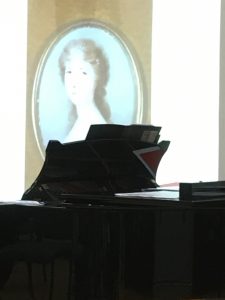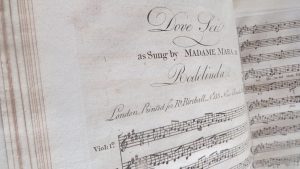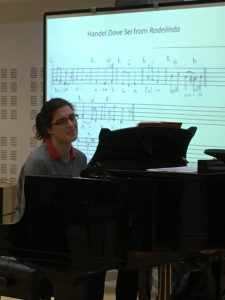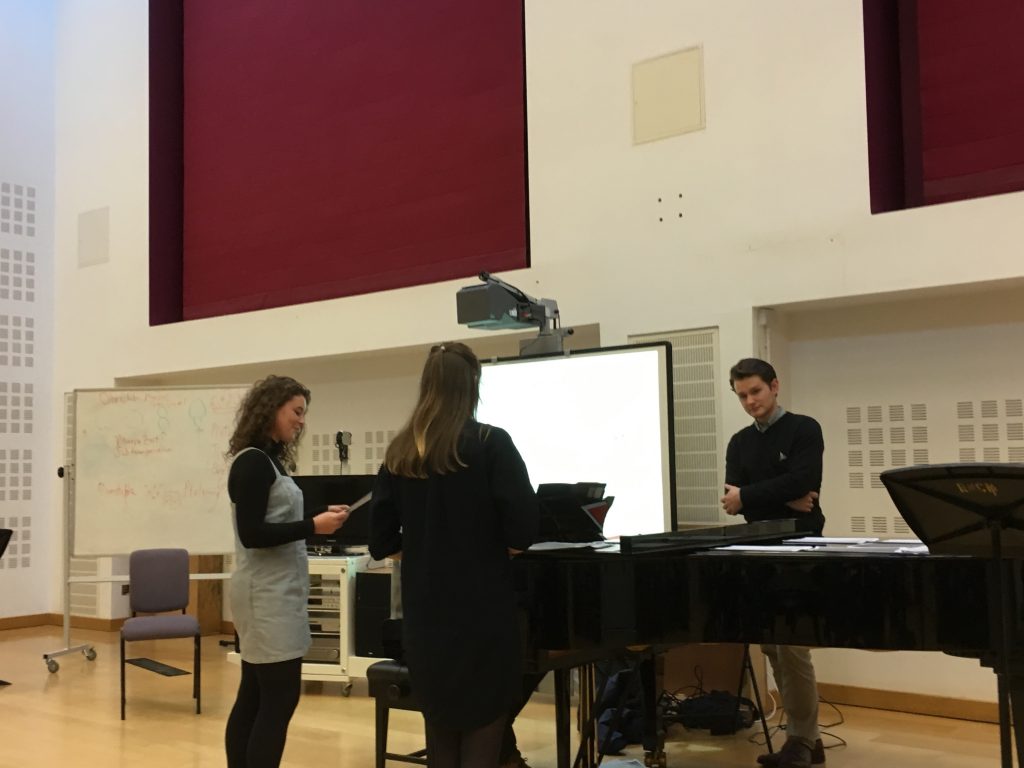Sound Heritage at the RNCM
 Last month Southampton PhD student Catherine Garry joined the Sound Heritage network at Tatton Park (Cheshire), for a study day featuring music from the house’s extensive library. Sound Heritage joined forces with the Royal Northern College of Music to explore the music collected by Elizabeth Sykes, who married into the Egerton family of Tatton Park in the early 19th century. Here Catherine describes the public workshop put on by the RNCM team the day before the performance:
Last month Southampton PhD student Catherine Garry joined the Sound Heritage network at Tatton Park (Cheshire), for a study day featuring music from the house’s extensive library. Sound Heritage joined forces with the Royal Northern College of Music to explore the music collected by Elizabeth Sykes, who married into the Egerton family of Tatton Park in the early 19th century. Here Catherine describes the public workshop put on by the RNCM team the day before the performance:
On Thursday 10th November Sound Heritage were privileged to be invited to the Royal Northern College of Music to take part in a workshop on some of the music from the collection at Tatton Park. The workshop was led by historical performance specialist Harvey Davies. Vocal students of the College – including Isabella Cheevers; Rachel Spiers; Helen Lacy; Isla MacEwan and Stuart Orme, accompanied by pianist Emily Hooker – performed a variety of items from Elizabeth Sykes’s music books, rehearsing for their concert at Tatton Park the following day. This workshop gave Sound Heritage members the opportunity to listen to and discuss items of the collection with the singers in detail, and offer advice from historical and musicological perspectives.
 During the workshop, students performed a selection of Italian operatic music and English songs from the collection, reflecting Elizabeth’s wide-ranging musical tastes. The workshop began with a performance of “Dove sei” from Handel’s Rodelinda (1725) by Master’s student Isabella Cheevers. This piece appears twice in Elizabeth’s collection. “Dove sei” was a staple item for 18th-century domestic performers of Italian opera, recommended by singing teachers to students wishing to improve their operatic vocal technique. Isabella performed from Elizabeth’s hand-copied edition, which is heavily annotated and ornamented. Isabella performed this aria both with and without the added ornamentation, to highlight the contrast between the two versions and to emphasise the significance of the embellishments on the melody and the aria’s character. Isabella was offered guidance on how to approach this ornamentation, specifically focusing on how to create enough space for the ornamentation in the melody and through the use of rubato. The workshop also featured a performance of the Italian duet “Crudel perche finora,” from Mozart’s Le nozze di Figaro, by Rachel Spiers and Stuart Orme. For this item, the performers were encouraged to focus on the connection between the two characters and the closely harmonized melodies, in order to further emphasise the aria’s romantic storyline.
During the workshop, students performed a selection of Italian operatic music and English songs from the collection, reflecting Elizabeth’s wide-ranging musical tastes. The workshop began with a performance of “Dove sei” from Handel’s Rodelinda (1725) by Master’s student Isabella Cheevers. This piece appears twice in Elizabeth’s collection. “Dove sei” was a staple item for 18th-century domestic performers of Italian opera, recommended by singing teachers to students wishing to improve their operatic vocal technique. Isabella performed from Elizabeth’s hand-copied edition, which is heavily annotated and ornamented. Isabella performed this aria both with and without the added ornamentation, to highlight the contrast between the two versions and to emphasise the significance of the embellishments on the melody and the aria’s character. Isabella was offered guidance on how to approach this ornamentation, specifically focusing on how to create enough space for the ornamentation in the melody and through the use of rubato. The workshop also featured a performance of the Italian duet “Crudel perche finora,” from Mozart’s Le nozze di Figaro, by Rachel Spiers and Stuart Orme. For this item, the performers were encouraged to focus on the connection between the two characters and the closely harmonized melodies, in order to further emphasise the aria’s romantic storyline.
 In contrast, the workshop also saw performances of several English items, including Harriett Abrams’ “Crazy Jane” by BMus student Helen Lacy. This song depicts the story of a madwoman who has been abandoned by her lover. It was an extremely popular item with amateur performers in the 18th century and it features in a vast range of surviving domestic music collections, including the Austen family collection. Elizabeth’s version is annotated with ornamentation, suggesting she enjoyed performing the song and wanted to add her own interpretation. Jeanice and Harvey encouraged Helen to focus on the dramatic elements of her performance, expressing the sorrow and decline of “Crazy Jane” and emphasising the musical devices that accentuate the drama to generate both compassion and amusement from audiences. Another comic English item performed during the workshop was Samuel Webbe’s glee arrangement of Haydn’s canzonet “My mother bids me bind my hair.” The performers were encouraged to stand around the piano facing each other rather than the audience, to encourage impromptu interactions between them and thus enhance the comic aspects of the musical arrangement. These performance positions also simulated the casual performance environment that might have occurred in the Sykes’s family home.
In contrast, the workshop also saw performances of several English items, including Harriett Abrams’ “Crazy Jane” by BMus student Helen Lacy. This song depicts the story of a madwoman who has been abandoned by her lover. It was an extremely popular item with amateur performers in the 18th century and it features in a vast range of surviving domestic music collections, including the Austen family collection. Elizabeth’s version is annotated with ornamentation, suggesting she enjoyed performing the song and wanted to add her own interpretation. Jeanice and Harvey encouraged Helen to focus on the dramatic elements of her performance, expressing the sorrow and decline of “Crazy Jane” and emphasising the musical devices that accentuate the drama to generate both compassion and amusement from audiences. Another comic English item performed during the workshop was Samuel Webbe’s glee arrangement of Haydn’s canzonet “My mother bids me bind my hair.” The performers were encouraged to stand around the piano facing each other rather than the audience, to encourage impromptu interactions between them and thus enhance the comic aspects of the musical arrangement. These performance positions also simulated the casual performance environment that might have occurred in the Sykes’s family home.
Overall the workshop was extremely enjoyable and it was a privilege for Sound Heritage members to participate in the learning process of this repertoire. It was fascinating to witness historical and performance experts offer advice to the students much in the way that a singing teacher might have guided Elizabeth Sykes when she was collecting and learning this music. The small selection of items performed epitomized the range and diversity of Elizabeth’s collection, bringing the trends of late 18th-century vocal repertoire and singing technique into the 21st century.

